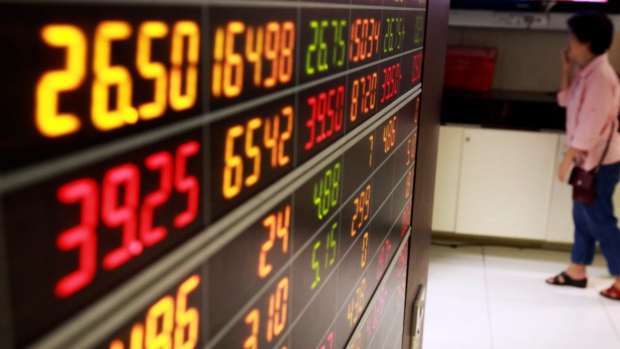Nov 16, 2018
Stocks drop as trade war simmers; U.S. dollar slips
, Bloomberg News

U.S. stocks finished the day higher as trade hopes rose, but they couldn’t compensate for a rocky week in which the retail picture soured and technology shares languished. Treasuries advanced and the dollar retreated.
Equity markets have reacted swiftly to trade-related headlines in recent days as investors look for any hint that the threat of more tariffs will be removed, and the S&P 500 Index surged Friday after U.S. President Donald Trump appeared to signal a willingness to reach a deal with China at this month’s G-20 summit.
In Canada, the S&P/TSX Composite Index ended Friday barely green, up 3.21 points to 15,148.09.
But those gains were tempered by flagging consumer and retail shares. Department-store chain Nordstrom Inc. declined on disappointing results, following letdowns from Macy’s Inc. and Dillard’s Inc. Technology stocks wavered as chipmaker Nvidia Inc. had its worst trading day in a decade after issuing a lower-than-expected fourth-quarter outlook.
At the same time, California utilities PG&E Corp. and Edison International began to recover from steep losses brought on by the wildfires that swept the state. Energy firms also advanced as crude continued its rally after a record losing streak. All told, the S&P 500 fell 1.6 per cent on the week.
“There’s a lot of things that the market’s wondering about with Trump’s latest announcement on trade. It’s obviously an unsettled issue and something that will continue to drive the markets for a few weeks,” said Curtis Holden, senior investment officer at Tanglewood Total Wealth Management, who added: “You’re seeing some anxiety, too, over Christmas spending, which is typical for this time of year.”
Equity markets remain volatile as the slowing Chinese economy and uncertain outlook for earnings coincide with investors’ adjusting to the effects of tightening U.S. monetary policy. Political tensions in Europe -- from the U.K. to Italy -- are also hitting sentiment. Sterling advanced as investors grappled with Britain’s political turmoil, while oil hovered around US$57 a barrel in New York.
Some of the pressure on the dollar and bond yields followed remarks by Federal Reserve Vice Chairman Richard Clarida, who said on Friday that policy is getting close to neutral and there is some evidence of global slowing.
The British pound managed to rebound after posting the biggest drop in more than two years Thursday as several ministers resigned. Prime Minister Theresa May is defying demands to quit as her detractors plot a vote of no confidence over disquiet with her proposed Brexit deal.
The Stoxx Europe 600 Index had its worst week in three. Asian shares were led lower by declines in Japan, even as those in China and Hong Kong climbed. Emerging market stocks and currencies edged higher. Gold climbed alongside nickel and aluminum.
These are the main moves in markets:
Stocks
The S&P 500 Index rose 0.2 per cent as of 4 p.m. New York time. The Stoxx Europe 600 Index declined 0.2 per cent to the lowest in more than two weeks. The U.K. FTSE 100 Index decreased 0.3 per cent. The MSCI Emerging Market Index increased 0.7 per cent to the highest in more than a week.
Currencies
The Bloomberg Dollar Spot Index declined 0.6 per cent to the lowest in over a week. The euro gained 0.8 per cent to US$1.1416, the strongest in more than a week. The British pound advanced 0.4 per cent to US$1.2827. The Japanese yen gained 0.7 per cent to 112.81 per dollar, the biggest gain in four months.
Bonds
The yield on 10-year Treasuries dipped four basis points to 3.07 per cent, the lowest in more than six weeks. Germany’s 10-year yield climbed one basis point to 0.37 per cent. Britain’s 10-year yield gained four basis points to 1.412 per cent.
Commodities
West Texas Intermediate crude increased 0.6 per cent to US$56.80 a barrel. Gold increased 0.7 per cent to US$1,222.03 an ounce, the highest in more than a week. LME copper gained 0.3 per cent to US$6,205.00 a metric ton. The Bloomberg Commodity Index gained 1.3 per cent.